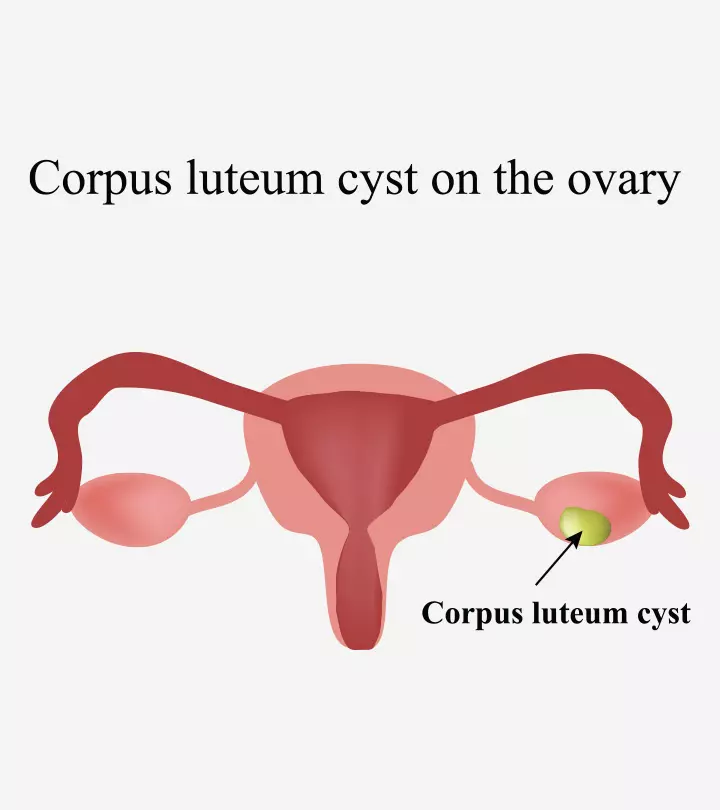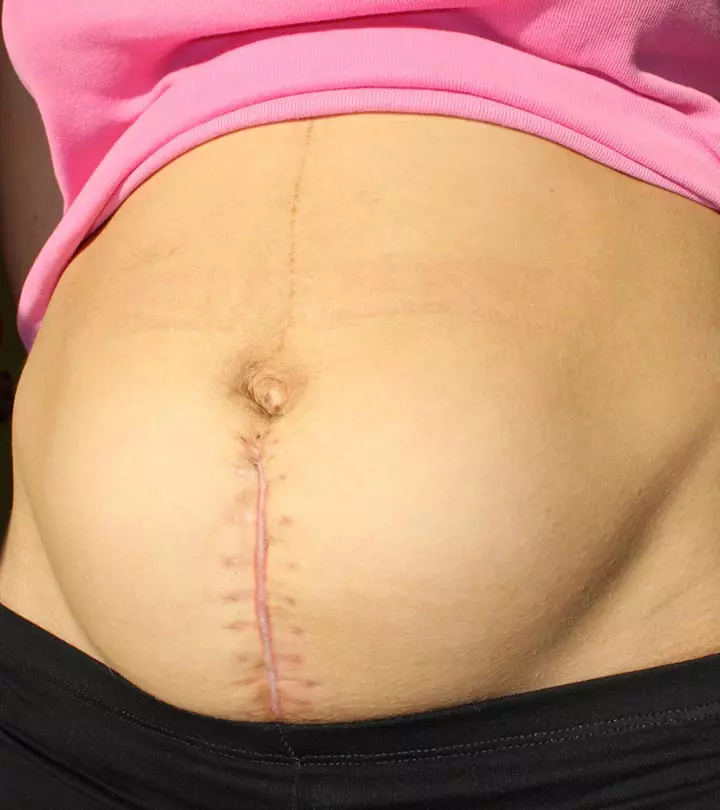
Image: iStock
A bulging fontanelle in infants is characterized by the outward appearance of their soft spot (fontanelle). Under normal conditions, the fontanelle is curved inwards. But when the pressure inside the brain increases or if there is a fluid buildup, the tension within leads to the protrusion and formation of the dome-shaped fontanelle, making the baby’s head appear bulged. The condition could be accompanied by fever and may require medical care. Read on to know more about the causes of bulging fontanelle, its diagnosis, and treatment.

Key Pointers
- An infant may develop a bulging fontanelle due to tumors or trauma, among other reasons.
- Congenital hypothyroidism, meningitis, and high intracranial pressure could also lead to bulging fontanelle.
- Fever and bulging soft spots are an indication you should visit the doctor.
What Is Fontanelle In Infants?

The skull consists of several bones, of which eight bones enclose and protect the brain. Each bone meets at a joint called a suture. In adults, the sutures are closed, but in infants, there is a space between the sutures filled with membranous tissue. The space between the sutures is called a fontanelle or soft spot.
The function of fontanelle is to allow the baby’s head to mold during delivery and support the brain’s growth during infancy. The sutures fuse over time due to the addition of minerals, and the soft spot eventually disappears without any distension or bulging.
Since the skull has multiple bones, a baby has multiple fontanelles that close at different stages of infancy and toddlerhood (1). The following are the most notable fontanelles and the age at which they usually close.
- Posterior fontanelle, situated in the back of the head, closes by one to two months of age.
- Anterior fontanelle, on top of the head, closes between seven and 19 months after birth.
 Quick fact
Quick factNormally the fontanelles feel firm and slightly curved inward to the touch. It is normal for fontanelles to bulge when an infant cries, vomits, or lays down. They return to normal when the infant is calm, in a head-up position. However, bulging fontanelle in other situations can be an indication of a pathology. A tense or bulging fontanelle occurs when fluid builds up in the brain or the brain itself swells – in any condition leading to increased pressure inside the skull.
Causes Of Bulging Fontanelle
It is important to note that bulging fontanelle is not a disease itself but rather a sign of an underlying disease or condition that causes increased intracranial pressure.iPressure within the skull due to the brain, cerebrospinal fluid (CSF), and blood volume.
An infant may have bulging fontanelle due to the following reasons (2).
- Hydrocephalus, a condition that causes fluid buildup in the skull
A mom of four, Vicky Herbert, shares about her youngest son, Ethan, who was diagnosed with hydrocephalus that led to the bulging of his fontanelle. She writes, “Ethan was born nine weeks early, weighing 3lbs 10oz, and following a traumatic birth, where the umbilical cord was wrapped tightly around his neck, he suffered a bleed on the brain… Hydrocephalus was mentioned during this conversation, more to make us aware than anything else… He was still in the special care baby unit at this time, and one week later, I arrived at the unit and knew instantly that he had developed Hydrocephalus. His fontanelle was full and bulging, making his head appear cone-shaped. I had read a little about Hydrocephalus since it was mentioned last week and immediately recognized the signs (i).”
- Encephalitis, swelling of the brain tissue commonly due to infections
- Meningitis, an inflammation of the brain membranes
- Intracranial hemorrhage
- Head trauma

- Hypoxic-ischemic injury due to deprivation of oxygen to the brain
- Congenital hypothyroidismiA thyroid hormone deficiency, present at birth, when the thyroid gland is unable to function properly or is not developed properly.
- Tumors
- Certain genetic syndromes
Recently, studies have shown that vitamin A deficiency and excess vitamin A supplementation may also cause bulging fontanelles in young infants. This is due to vitamin A toxicity caused by increased benign intracranial hypertension (BIH). However, the occurrence of vitamin A-associated bulging fontanelle is rare and reversible (6). Additionally, head trauma due to a fall can cause temporary bulging fontanelle and swelling (7).
You may seek medical care to identify and begin treatment of causes since brain anomalies may lead to severe complications.
 Be watchful
Be watchfulWhen To See A Doctor?
Prompt medical care is required if your baby has bulging fontanelle. Symptoms that may indicate a problem requiring emergency care include (1):
- Fever
- Changes in appetite
- Persistent vomiting
- Irritability
- Drowsiness
- Enlargement of soft spots
Contact the doctor if the fontanelle is protruding, even if the baby remains calm and has no other symptoms.
Diagnosis Of Bulging Fontanelle
Medical history and physical examination may help to identify raised or expanded bulging fontanelle and its causes.
The following tests may be done (3).
- Lumbar punctureiA medical procedure that requires a needle to be inserted into the lower back for the collection of a sample of cerebrospinal fluid (CSF) for diagnostic testing or to inject medication. or spinal tap
- Blood tests
- CT scan of the head
- MRI scan of the head
 Things to know
Things to know
Treatment For Bulging Fontanelle

The treatment options may vary according to the cause and may include the following:
- Brain infections are treated with antibiotics or antivirals, depending on the etiologic agents.
- Surgical procedures may be performed to create shunts to drain excess fluid in case of hydrocephalus in babies
- Surgical removal of tumors is done if present
- Thyroid hormone replacement therapy could help infants with thyroid abnormalities
- Intracranial pressure is managed with medications if present
Regular pediatric check-ups are crucial for tracking an infant’s development and assessing fontanelles. Create a safe environment during your baby’s growth phase to prevent incidents that could lead to head trauma. Stay alert for signs that require immediate medical attention to catch potential issues early and avoid complications.
Frequently Asked Questions
1. Does bulging fontanelle go away?
If an underlying condition or pathology is causing a prominent bulging fontanelle, it does not go away on its own. It warrants immediate medical attention.
2. Does bulging fontanelle mean dehydration?
No, dehydration in babies causes a sunken fontanelle. A bulging fontanelle usually occurs due to increased intracranial pressure or intracranial or extracranial tumors (2).
3. How big should the fontanelle be at three months?
The fontanelle of a healthy three-month-old may measure between 0.8 and 6.9cm (4).
4. Can a virus cause a bulging fontanelle?
Yes. A viral infection, such as COVID-19, can cause a bulging fontanelle, or “soft spot,” in an infant (5).
5. What happens if fontanelle is pressed?
Pressing into the “soft spot” or fontanelle of an infant is generally not recommended because it can cause discomfort, tenderness, or throbbing sensation to the baby and may also cause damage or injury.
A bulging fontanelle could be caused due to multiple reasons. However, you need not worry as there are several ways of treating it. To ensure that you are opting for the right type of treatment, it is advisable to consult your child’s pediatrician and understand the process that they suggest to treat the bulge. Usually, they examine the signs and will perform a complete medical checkup before coming up with a treatment plan. Ensure not to delay the process for your child’s safety and well-being.
Infographic: Bulging Fontanelle And Its Causes
Bulging fontanelle may require prompt medical treatment but it is helpful to know its causes. Check this infographic to have a glance at the condition and its causes.
Some thing wrong with infographic shortcode. please verify shortcode syntax
View this incredible video of a cute baby with an extremely bulging fontanelle to understand the significance of this condition and the subsequent procedures to be followed.
Personal Experience: Sources
MomJunction articles include first-hand experiences to provide you with better insights through real-life narratives. Here are the sources of personal accounts referenced in this article.
i. Hydrocephalus – A Parents view;https://vickyherbert.wordpress.com/2013/05/14/hydrocephalus-a-parents-view/
References
1. Fontanelles-Bulging; MedlinePlus; US National Library of Medicine
2. The Abnormal Fontanel; The American Academy of Family Physicians
3. What Causes a Bulging Anterior Fontanelle?; Pediatric Education
4. Mohammad Esmaeili et al.; Fontanel Size from Birth to 24 Months of Age in Iranian Children; National Library of Medicine
5. Jared Schiff and Courtney Brennan; Covid-19 presenting as a bulging fontanelle; The American journal of emergency medicine; NCBI 6. Jean H. Humphrey and Rebecca N. Ichord; Safety of vitamin A supplementation of postpartum women and young children; Food and Nutrition Bulletin.
7. What To Know About Baby’s Fontanelles (aka Soft Spots); Cleveland Clinic
Community Experiences
Join the conversation and become a part of our nurturing community! Share your stories, experiences, and insights to connect with fellow parents.
Read full bio of Dr. Pooja Parikh
Read full bio of Dr Bisny T. Joseph
Read full bio of Rohit Garoo
Read full bio of Shinta Liz Sunny

















